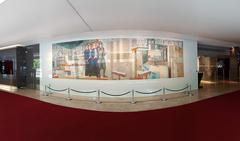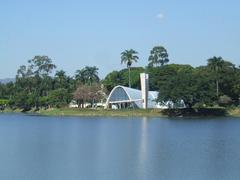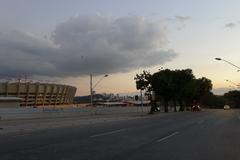Conjunto Governador Kubitschek: Visiting Hours, Tickets, and Complete Guide to Belo Horizonte’s Modernist Landmark
Date: 03/07/2025
Introduction: A Modernist Icon in the Heart of Belo Horizonte
Conjunto Governador Kubitschek—commonly known as Conjunto JK or Edifício JK—is one of Belo Horizonte’s most celebrated historical sites and a towering symbol of Brazilian modernism. Conceived in the early 1950s by then-governor Juscelino Kubitschek and designed by the legendary Oscar Niemeyer with structural engineering by Joaquim Cardozo, Conjunto JK was envisioned as a “cidade dentro da cidade” (“city within a city”). This pioneering concept sought to integrate residential, commercial, and cultural spaces, offering a self-sufficient urban environment that reflected the optimism and ambition of mid-20th-century Brazil (conjuntojk.com; BHAZ).
The complex stands as one of Latin America’s largest residential developments of its era, with two monumental towers—Bloco A and Bloco B—linked by an iconic passarela and elevated on pilotis, creating open and accessible public spaces at street level. Today, Conjunto JK is home to around 5,000 residents and serves as a living experiment in urban community, social integration, and modernist architecture. Designated as a historic monument by Belo Horizonte’s Cultural Heritage Council in 2022, it continues to captivate architecture enthusiasts, history buffs, and travelers alike (Designboom; Revista RU3).
This detailed guide explores Conjunto JK’s origins, architecture, cultural significance, and provides all practical information—including visiting hours, tickets, travel tips, accessibility, and nearby attractions—to help you make the most of your visit to this Belo Horizonte landmark (WildTrips; Abreu Digital).
Table of Contents
- Origins and Vision
- Architectural Innovation and Modernist Ideals
- Construction and Urban Impact
- Social and Cultural Legacy
- Evolution, Preservation, and Heritage Status
- Practical Visitor Information
- Nearby Attractions
- Frequently Asked Questions (FAQ)
- Additional Resources and References
Origins and Vision
Conjunto JK was conceived during a period of accelerated urbanization in Belo Horizonte, under the leadership of Juscelino Kubitschek. The project aimed to address the city’s growing need for modern housing and to symbolize Belo Horizonte’s aspirations for progress and modernity. Oscar Niemeyer’s bold design—presented in 1951—brought to life a complex that would become a benchmark for large-scale, inclusive urban development in Brazil (conjuntojk.com; Wikipedia).
Architectural Innovation and Modernist Ideals
Niemeyer’s vision for Conjunto JK embodied the key tenets of modernist architecture: clean lines, functional forms, and social integration. The two towers—Bloco A (23 floors) and Bloco B (36 floors)—are connected by an elegantly arched passarela and elevated on pilotis, opening up the ground level for public use. The complex originally included a wide range of amenities: a hotel, cinema, museum, theater, restaurants, shops, playgrounds, and an underground bus terminal. This “city within a city” model revolutionized urban residential life in Belo Horizonte and remains an influential example of modernist planning (ArchDaily; BHAZ).
Construction and Urban Impact
The construction of Conjunto JK was a massive technical and logistical undertaking, extending from the early 1950s into the 1970s. With Bloco B reaching a height of approximately 120 meters, it was the tallest building in Belo Horizonte for many years (curraldelrei.blogspot.com; Wikipedia). The project set new standards in density and urban integration, housing over 1,000 apartments in 13 different configurations and accommodating a diverse population from various social backgrounds.
Social and Cultural Legacy
From its inception, Conjunto JK was more than just a housing project—it was an ambitious social experiment designed to foster a heterogeneous, integrated community. The complex attracted residents from all walks of life—students, professionals, artists, and families—mirroring Belo Horizonte’s social diversity. Over the decades, the communal spaces have evolved in response to shifting needs, with some original venues repurposed as a police station, church, or retail stores. Despite challenges in maintenance and governance, the sense of community and resilience among residents remains strong (Abreu Digital; Revista RU3).
Evolution, Preservation, and Heritage Status
In 2022, Conjunto JK was officially designated as a cultural heritage site by Belo Horizonte’s Council for Cultural Heritage. This recognition not only protects the complex’s architectural integrity but also acknowledges its enduring social and cultural significance. Restoration efforts and ongoing community participation are vital to preserving the site for future generations (Designboom; BHAZ).
Practical Visitor Information
Location and Accessibility
- Address: Avenida do Contorno, 9727, Centro, Belo Horizonte, Minas Gerais, Brazil.
- Getting There: Easily accessible by public buses and a short walk from Central metro station. Taxis and ride-sharing services are also convenient (WildTrips).
- Accessibility: Public plazas and ground-level commercial areas are generally accessible to visitors with mobility needs, but some older sidewalks and entrances may have limitations.
Visiting Hours and Ticketing
- Visiting Hours: Outdoor public areas and commercial galleries are open throughout the day, typically from 9:00 AM to 6:00 PM. There are no official visiting hours since the site is primarily residential.
- Tickets: No admission fee is required to visit public areas. Access to private residential spaces is restricted.
- Guided Tours and Special Events: Occasionally, guided tours or events are organized during cultural festivals or architecture weeks. For updated information, contact Belo Horizonte’s tourism office or check the official websites (BHAZ).
Travel Tips
- Best Time to Visit: The dry season (May to September) offers mild weather and is ideal for walking tours (WildTrips).
- What to Bring: Camera, comfortable shoes, sun protection, and water bottle.
- Safety: The city center is generally safe during the day; exercise caution at night and be mindful of valuables.
Photography Spots and Social Media
- Best Views: Capture the complex’s monumental façade from surrounding streets and plazas, especially during early morning or late afternoon.
- Social Media: Use hashtags like #ConjuntoJK and #BeloHorizonte to connect with local and global communities interested in architecture and urban culture.
Architectural Highlights and Points of Interest
- Towers: Bloco A (23 floors) and Bloco B (36 floors), featuring bold modernist lines and sweeping curves.
- Façade: Characterized by rhythmic repetition of windows and balconies, creating a dynamic interplay of light and shadow.
- Ground-Level Plazas: Vibrant commercial galleries with shops, cafes, and small businesses, offering a glimpse into daily community life.
- Passarela: The elevated walkway connecting the towers—an architectural and visual highlight.
Nearby Attractions
Conjunto JK’s central location makes it an excellent base for exploring other Belo Horizonte historical sites:
- Praça Raul Soares: A bustling public square nearby.
- Mercado Central: The city’s vibrant central market.
- Praça da Liberdade: Surrounded by museums and cultural centers (iHeartBrazil).
- Niemeyer Building: Another Oscar Niemeyer masterpiece.
- Edifício Maletta: Historic mixed-use building popular for dining and nightlife.
Frequently Asked Questions (FAQ)
Q: Are there official visiting hours for Conjunto JK?
A: No official hours; public areas are accessible during the day, typically 9:00 AM–6:00 PM.
Q: Is there an entry fee?
A: No, public areas and ground-level galleries are free to visit.
Q: Can I enter the residential towers?
A: No, access to residential areas is restricted to protect residents’ privacy.
Q: Are guided tours available?
A: Occasionally, during festivals or by arrangement with local cultural groups. Check Belo Horizonte tourism resources.
Q: Is Conjunto JK accessible for visitors with mobility challenges?
A: Public plazas are generally accessible, though some older areas may be less so.
Additional Resources and References
- Conjunto Governador Kubitschek: A Modernist Icon and Must-Visit Historical Site in Belo Horizonte, Designboom
- Edifício JK Visitor Guide, BHAZ
- Visiting Conjunto Governador Kubitschek (Conjunto JK): Social Impact, History, and Visitor Information, Abreu Digital
- Conjunto JK Visiting Hours, Tickets & Guide to Belo Horizonte Historical Site, WildTrips
- Conjunto Governador Kubitschek, Wikipedia
- Edifício JK, Wikipedia
- Classic Architecture: Conjunto Governador Juscelino Kubitschek by Oscar Niemeyer, ArchDaily
- O Conjunto JK, Marca Registrada da Arquitetura Modernista, Curral de Rei Blogspot
- No Edifício JK, O Patrimônio Cultural, Revista RU3
- Belo Horizonte Skyline: Most Iconic Buildings and Best Views, Wanderlog
- iHeartBrazil - Things to Do in Belo Horizonte
Plan Your Visit and Stay Connected
Conjunto Governador Kubitschek is more than just a landmark of Brazilian modernism—it is a living testament to the city’s history, diversity, and cultural evolution. Experience its grandeur, explore its vibrant community, and discover nearby attractions to fully immerse yourself in Belo Horizonte’s unique urban narrative.
For guided audio tours, insider tips, and the latest updates on historical sites in Belo Horizonte, download the Audiala app and follow us on social media. Share your experiences and connect with fellow travelers and architecture lovers using #ConjuntoJK and #BeloHorizonte.




